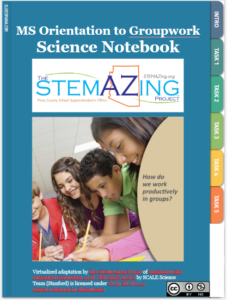7th Grade AzSS-Aligned Resources

Lessons, videos, storylines, phenomena, and more all curated by The STEMAZing Project to link directly to 2018 Arizona Science Standards.
- 7.P2U1.1 (NGSS-P: MS-PS2-3) Collect and analyze data demonstrating how electromagnetic forces can be attractive or repulsive and can vary in strength.
- 7.P2U1.2 (NGSS- P: MS-PS2-5) Develop and use a model to predict how forces act on objects at a distance.
- 7.P3U1.3 (NGSS-P: MS-PS2-4) Plan and carry out an investigation that can support an evidence-based explanation of how objects on Earth are affected by gravitational force.
- 7.P3U1.4 (NGSS-NC) Use non-algebraic mathematics and computational thinking to explain Newton’s laws of motion.
- 7.E1U1.5 (NGSS-P: MS-ESS2-1 & MS-ESS2-4) Construct a model that shows the cycling of matter and flow of energy in the atmosphere, hydrosphere, and geosphere.
- 7.E1U1.6 (NGSS-P: MS-ESS2-3) Construct a model to explain how the distribution of fossils and rocks, continental shapes, and seafloor structures provides evidence of the past plate motions.
- 7.E1U2.7 (NGSS-NC) Analyze and interpret data to construct an explanation for how advances in technology has improved weather prediction.
- 7.L1U1.8 (NGSS-P: MS-LS1-1) Obtain, evaluate, and communicate information to provide evidence that all living things are made of cells, cells come from existing cells, and cells are the basic structural and functional unit of all living things.
- 7.L1U1.9 (NGSS-P: MS-LS1-2) Construct an explanation to demonstrate the relationship between major cell structures and cell functions (plant and animal).
- 7.L1U1.10 (NGSS-NC) Develop and use a model to explain how cells, tissues, and organ systems maintain life (animals).
- 7.L1U1.11 (NGSS-NC) Construct an explanation for how organisms maintain internal stability and evaluate the effect of the external factors on organisms’ internal stability.
- 7.L2U1.12 (NGSS-P: MS-LS1-6) Construct an explanation for how some plant cells convert light energy into food energy.
- Other 7th Grade Resources
7.P2U1.1 (NGSS-P: MS-PS2-3) Collect and analyze data demonstrating how electromagnetic forces can be attractive or repulsive and can vary in strength.
No posts found.
No posts found.
7.P2U1.2 (NGSS- P: MS-PS2-5) Develop and use a model to predict how forces act on objects at a distance.
No posts found.
No posts found.
7.P3U1.3 (NGSS-P: MS-PS2-4) Plan and carry out an investigation that can support an evidence-based explanation of how objects on Earth are affected by gravitational force.
No posts found.
No posts found.
7.P3U1.4 (NGSS-NC) Use non-algebraic mathematics and computational thinking to explain Newton’s laws of motion.
No posts found.
No posts found.
7.E1U1.5 (NGSS-P: MS-ESS2-1 & MS-ESS2-4) Construct a model that shows the cycling of matter and flow of energy in the atmosphere, hydrosphere, and geosphere.

Youth Climate Action Toolkit
This Is Planet Ed partnered with The Nature Conservancy to design this toolkit with young leaders from across the country to share climate solutions that students can advocate for in schools. The Youth Climate Action ...

Youth Climate Action Toolkit
This Is Planet Ed partnered with The Nature Conservancy to design this toolkit with young leaders from across the country to share climate solutions that students can advocate for in schools. The Youth Climate Action ...
7.E1U1.6 (NGSS-P: MS-ESS2-3) Construct a model to explain how the distribution of fossils and rocks, continental shapes, and seafloor structures provides evidence of the past plate motions.
No posts found.
No posts found.
7.E1U2.7 (NGSS-NC) Analyze and interpret data to construct an explanation for how advances in technology has improved weather prediction.
No posts found.
No posts found.
7.L1U1.8 (NGSS-P: MS-LS1-1) Obtain, evaluate, and communicate information to provide evidence that all living things are made of cells, cells come from existing cells, and cells are the basic structural and functional unit of all living things.

Youth Climate Action Toolkit
This Is Planet Ed partnered with The Nature Conservancy to design this toolkit with young leaders from across the country to share climate solutions that students can advocate for in schools. The Youth Climate Action ...

Youth Climate Action Toolkit
This Is Planet Ed partnered with The Nature Conservancy to design this toolkit with young leaders from across the country to share climate solutions that students can advocate for in schools. The Youth Climate Action ...
7.L1U1.9 (NGSS-P: MS-LS1-2) Construct an explanation to demonstrate the relationship between major cell structures and cell functions (plant and animal).
No posts found.
No posts found.
7.L1U1.10 (NGSS-NC) Develop and use a model to explain how cells, tissues, and organ systems maintain life (animals).
No posts found.
No posts found.
7.L1U1.11 (NGSS-NC) Construct an explanation for how organisms maintain internal stability and evaluate the effect of the external factors on organisms’ internal stability.
No posts found.
No posts found.
7.L2U1.12 (NGSS-P: MS-LS1-6) Construct an explanation for how some plant cells convert light energy into food energy.

Photosynthetic Floatation – Science Snack from the Exploratorium
Photosynthetic organisms capture energy from the sun and matter from the air to make the food we eat, while also producing the oxygen we breathe. In this Snack, oxygen produced during photosynthesis makes leaf bits ...
Travel Deep Inside A Leaf
This video makes a great phenomenon video for students to notice and wonder. It is a great opening for lessons addressing how some plant cells convert light energy into food energy. (Thank you to STEMAZing ...

Photosynthetic Floatation – Science Snack from the Exploratorium
Photosynthetic organisms capture energy from the sun and matter from the air to make the food we eat, while also producing the oxygen we breathe. In this Snack, oxygen produced during photosynthesis makes leaf bits ...
Travel Deep Inside A Leaf
This video makes a great phenomenon video for students to notice and wonder. It is a great opening for lessons addressing how some plant cells convert light energy into food energy. (Thank you to STEMAZing ...
Other 7th Grade Resources

7th Grade AzSS vs NGSS Planning Guide
Great for cross-referencing the Arizona Science Standards to the Next Generation Science Standards (NGSS) when looking for resources from collections aligned to NGSS. S = strong alignment (same science and engineering practice, same content). P ...

Middle School Virtual Orientation to Groupwork Unit
This virtualized version of the Stanford SCALE Science Unit 0 - Orientation to Groupwork for 6th grade. was co-designed by Melissa Wilburn (6th grade STEMAZing Teacher Leader with the Marana Unified School District), Sherrie Dennis ...

7th Grade AzSS vs NGSS Planning Guide
Great for cross-referencing the Arizona Science Standards to the Next Generation Science Standards (NGSS) when looking for resources from collections aligned to NGSS. S = strong alignment (same science and engineering practice, same content). P ...

Middle School Virtual Orientation to Groupwork Unit
This virtualized version of the Stanford SCALE Science Unit 0 - Orientation to Groupwork for 6th grade. was co-designed by Melissa Wilburn (6th grade STEMAZing Teacher Leader with the Marana Unified School District), Sherrie Dennis ...
